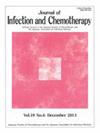Association between allergic bronchopulmonary aspergillosis or Aspergillus sensitization and tuberculosis: A systematic review of 607 cases
IF 1.5
4区 医学
Q3 INFECTIOUS DISEASES
引用次数: 0
Abstract
Introduction
Although allergic bronchopulmonary aspergillosis (ABPA) is classically described in asthma and cystic fibrosis, pulmonary tuberculosis (PTB) with post-tubercular lung disease (PTLD) has been reported as a likely predisposing factor. It, however, has not been reviewed systematically, which we aimed to achieve in the current systematic review.
Methods
We screened the available literature from PubMed, Embase, SCOPUS and Web of Science databases for studies reporting association between ABPA and PTB from the beginning of time to June 30, 2023 and collated the data on association of ABPA and tuberculosis.
Results
1176 articles were identified from the initial search, of which 60 articles (27 original articles and 33 case reports) were included in the final analysis. Four patterns were described: ABPA in patients with previous TB (151, 24.9 %), co-existent ABPA and TB (16, 2.6 %), Aspergillus sensitization in patients with prior or current TB (91, ∼15 %) and ABPA misdiagnosed as TB (349, 57.5 %). There was significant heterogeneity in the diagnostic criteria used for ABPA and pulmonary TB. From limited individual data, which could be extracted, observations were: 1) Central bronchiectasis (32.6 %), cavity (22.8 %), fungal ball (12.0 %), mucus plug/high attenuation mucus (HAM) (7.6 %) and consolidation/centrilobular nodules (12.0 %) were the most common radiographic abnormalities. 2) 96.4 % received steroids, 11 % received antifungals mostly for relapse or inadequate response. 3) Adequate treatment response was noted in the limited cohort where it was reported.
Conclusions
ABPA is commonly misdiagnosed as TB, but Aspergillus sensitization/ABPA can develop in patients with prior TB. However, significant heterogeneity in diagnostic criteria limits generalizability. Future well-designed prospective studies are required to confirm these associations.
607例过敏性支气管肺曲霉病或曲霉致敏与结核病的关系
虽然过敏性支气管肺曲霉病(ABPA)通常在哮喘和囊性纤维化中被描述,但肺结核(PTB)合并结核后肺病(PTLD)已被报道为可能的易感因素。然而,它还没有被系统地审查,这是我们在目前的系统审查中所要达到的目标。方法:我们从PubMed、Embase、SCOPUS和Web of Science数据库中筛选从发病时间开始至2023年6月30日报道ABPA与肺结核相关的文献,整理ABPA与肺结核相关的资料。结果:初检索到1176篇文献,其中60篇(27篇原创文献和33篇病例报告)纳入终分析。四种模式被描述为:既往结核病患者的ABPA (151, 24.9%), ABPA和结核病共存(16,2.6%),既往或当前结核病患者的曲霉致敏(91,~ 15%)和ABPA误诊为结核病(3449,57.5%)。ABPA和肺结核的诊断标准存在显著的异质性。从有限的个人资料中,我们观察到:1)中心性支气管扩张(24.8%)、空洞(19.6%)、真菌球(10.9%)、粘液塞/高衰减粘液(HAM)(7.6%)和小叶中心结节(6.5%)是最常见的影像学异常。2) 96.4%的患者接受类固醇治疗,11%的患者接受抗真菌药物治疗,主要是因为复发或治疗效果不佳。3)在报道的有限队列中注意到足够的治疗反应。结论:ABPA常被误诊为结核病,但曲霉致敏/ABPA可在既往结核病患者中发生。然而,诊断标准的显著异质性限制了通用性。需要未来精心设计的研究来证实这些关联。
本文章由计算机程序翻译,如有差异,请以英文原文为准。
求助全文
约1分钟内获得全文
求助全文
来源期刊

Journal of Infection and Chemotherapy
INFECTIOUS DISEASES-PHARMACOLOGY & PHARMACY
CiteScore
4.10
自引率
4.50%
发文量
303
审稿时长
47 days
期刊介绍:
The Journal of Infection and Chemotherapy (JIC) — official journal of the Japanese Society of Chemotherapy and The Japanese Association for Infectious Diseases — welcomes original papers, laboratory or clinical, as well as case reports, notes, committee reports, surveillance and guidelines from all parts of the world on all aspects of chemotherapy, covering the pathogenesis, diagnosis, treatment, and control of infection, including treatment with anticancer drugs. Experimental studies on animal models and pharmacokinetics, and reports on epidemiology and clinical trials are particularly welcome.
 求助内容:
求助内容: 应助结果提醒方式:
应助结果提醒方式:


